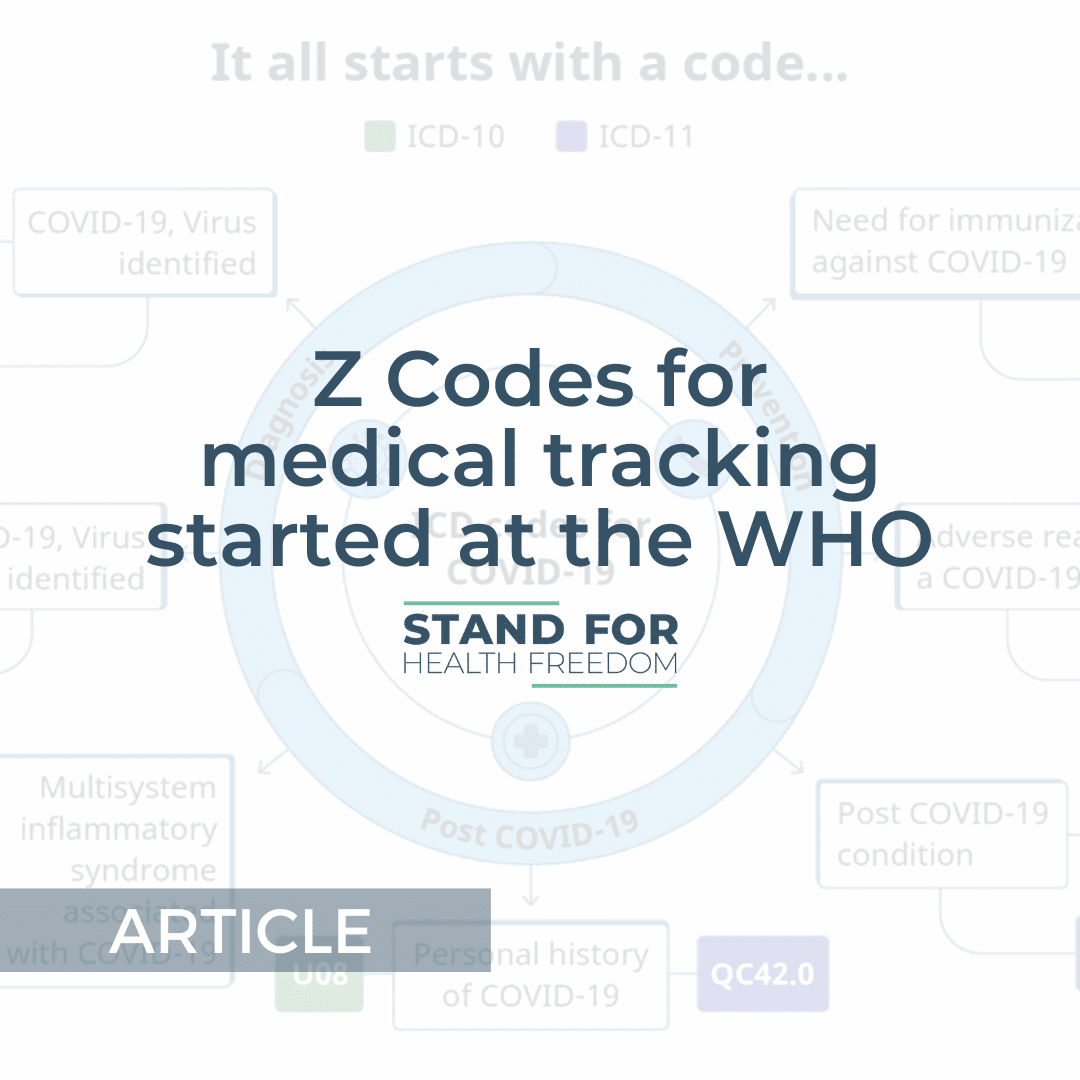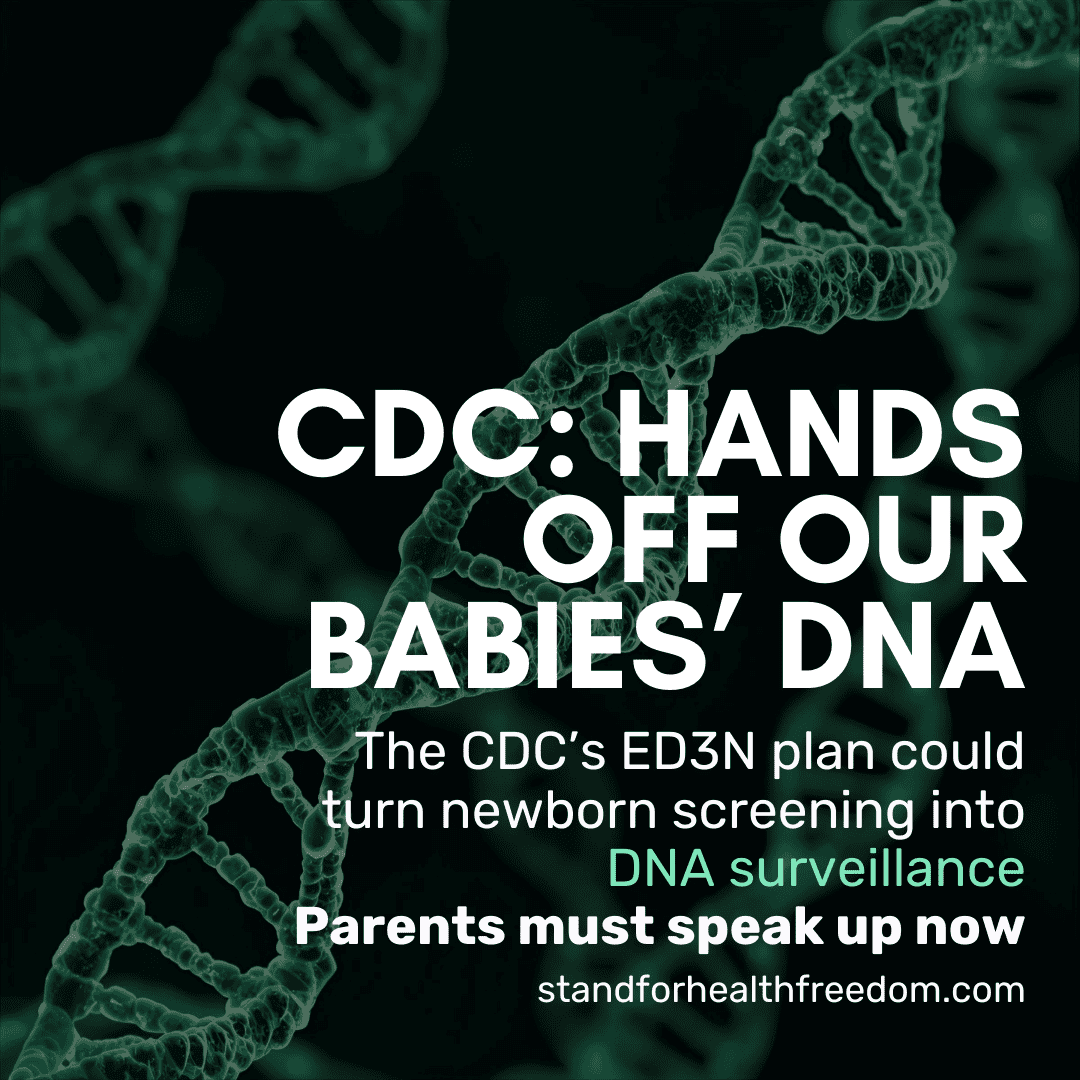“It all starts with a code.”
Many have been talking recently about the new medical codes designed to track those who are not considered fully vaccinated for COVID. Starting in April 2023, new codes will be available in the U.S. to note in a person’s medical record if they did not get the COVID shot, as well as why not.
To be clear, codes for underimmunization have been around for almost a decade. They were introduced during the Obama administration in 2015, including a code to indicate religious exemptions. But as we have more computer power to process medical codes, we’re seeing an ever-greater expansion, with greater specificity. Collection of data is not new, but what is new is the capacity to collect and store that data, the ability for others to obtain it, and the removal of the necessity for humans to process or scan it. (You can review ways to protect the health data privacy of your family and yourself at Stand for Health Freedom’s article Nothing to Hide, Nothing to Fear.) The 2022 addition of Z codes specific to COVID undervaccination marks the first time a specific immunization has been targeted in refusal codes.
Why do we use codes for medical care?
A health provider’s incentive to code is for payment. All HIPAA entities are required to use the International Classification of Diseases (ICD) codes, which were developed by the World Health Organization (WHO). When the WHO was created in 1948, it assumed the role of the central hub for world health data. The ICD refined and consolidated any previous attempts at trying to track and control diseases at a global level, at a time when travel by air and rail were just beginning. It was “created for the accurate tracking of diseases within a population.”[i]
As the owner of the ICD classification system, the WHO has a copyright and will grant licenses to countries for its use. Those that want to modify it, like the U.S., must have specific authorization and stay within the WHO guidelines.[ii] It’s available to buy in print in six languages, with databases in French or English.
The codification of medical decision making has swung the professional pendulum from art to science. And while that distinction may tickle those who revere the term “evidence-based,” it has distorted medical care to the point that providers feel their hands are tied. The need to treat within a code set, complete with incentivization of one-ill-one-pill approaches, has put patients in danger at the hands of the very people who made it their life’s work to “do no harm.” In an interview with Stand for Health Freedom Director Leah Wilson, electronic health record expert Twila Brase, R.N., painted the bleak picture of “compliance, not care” for providers who are bound to get paid only if their codes are in line with what an algorithm expects. Terms like “quality,” “meaningful use,” and “value” are defined in U.S. law based on how the artificial intelligence has been programmed to expect a health encounter to go. And if a provider does something differently, payment will be affected. All those machine-made decisions are dependent on a standardized language, which is the ICD.
The ICD basically creates a new language, which is not meant for humans, with the goal of global standardization. Diseases are categorized so they can be turned into payment decisions or statistics. One professional refers to the ICD as a “common denominator to be used in language-independent documentation of medical information.”[iii] In fact, the WHO refers to it as a “common language” for global standardization to “record, report, and monitor diseases.”
Most countries (117) use ICD only to report death data to the WHO. But all members of the WHO are “expected” to use the standardized code for reporting morbidity and mortality. Increased reporting requirements and data sharing are core features of the looming updates to the current International Health Regulations, as well as the pandemic treaty.
The WHO is the organization that creates the ICD versions but, in the words of the CDC, the WHO has “authorized” the CDC to create additional codes within the WHO framework.[iv] In 1988, the U.S. Congress passed the Medicare Catastrophic Coverage Act, which created the first requirement for providers to use the ICD diagnosis codes on claims forms as a prerequisite for payment. The ICD became required for HIPAA providers in the late 1990s with the creation of that law. As former president Obama took office in 2009, the new ICD-10 was adopted by HHS as the new coding system, but it was so costly and complicated to implement that it wasn’t required until 2015, near the end of the Obama administration.
What are the codes used for?[v]
- The first use listed by the WHO on their website is for “governments to allocate resources.”
- Payments in the U.S. hinge on ICD codes, which are given to health insurance companies to use when they are evaluating whether to pay your claim. If the diagnosis code does not match the procedure or treatment given by the one-size-fits-all algorithm they have created, an insurance claim will be denied.
- They are used by CMS to determine if Medicare and Medicaid patients are getting “value-based care.”
- Researchers, clinicians, and public health entities will comb ICD codes for statistics.
- ICD codes can be used to recruit and track volunteers for clinical trials.
- The codes are used to develop standardized algorithms for “decision support” in health care.
- Researchers to collaborate across legal borders.
- International organizations to assess health trends.
What are Z codes?
The ICD chapters are arranged alphabetically, in large buckets (for example, one chapter is for pregnancy, another for digestive, another for circulatory). Z Codes are not diagnoses, but instead they tell a story about why a person is having a medical visit, and factors that affected their compliance with medical advice. Z codes are, not surprisingly, found in the last chapter of the ICM, Chapter 21, titled Factors Influencing Health Status and Contact with Health Services.[vi] The guidelines for using the codes encourage providers to use Z codes to create data about “medical decision making.” According to the CDC, they “indicate a reason for an encounter or provide additional information about a patient encounter.”[vii]
Basically, Z Codes collect information about individuals and their families that is more about personal circumstances and experiences. There are codes related to literacy, homelessness, discord with counselors, sibling rivalry, injuries on eBikes, or as a result of terrorist activity, or vaping. There are codes for legal conflicts, for religious refusal of treatment, family histories of conditions, occupational exposures, unwanted pregnancy, convictions and “other legal circumstances,” and of course immunization status, including why the individual is “undervaccinated.”
The previous version of the ICD had around 14,000 codes. The 10th version of the ICD allowed for the list to expand like an accordion to accommodate new diseases and distinctions as they emerged. This left the space for things like Z codes that digitally identify people who have refused vaccination for religious reasons (Z28.1) and to track “underimmunization” for COVID-19 (Z28.3), and when a provider does not immunize because of caregiver refusal, natural immunity, or not having the drug on hand to give (Z28.8).
Z codes for underimmunization status (Z28 series) were introduced in 2016 by the World Health Organization. One code used for religious exemptions was labeled “patient decision for reasons of belief or group pressure.” It’s notable that when the codes were created in 2016, the American Academy of Pediatrics counseled their members that this code can be applied whether the patient claims it or not.[viii] What’s new, however, is that it specifies the shot — COVID — rather than simply noting a child is not up to date with the ACIP immunization schedule. It also adds more granularity — why did this person not get this specific shot: Was it because of caregiver refusal, natural immunity, the provider ran out?
[/et_pb_text]
Since the proposal was made in 2021, the definition of fully vaccinated seemed to have changed by the day because of the rapid alterations in Emergency Use Authorizations that were quickly recommended by the CDC. A question was posed about how the codes accounted for that. In response, David Berglund said the status of “undervaccination” would not be considered clinically. In other words, health professionals were not the ones who would determine if a person had a specific medical status. Who would then? The meaning of the code would “change with time,” meaning, it would change when the CDC changed their recommendations again.
Jene Yoder from the Defense Health Agency, who was on the call, chimed in with no questions, but only to share her excitement: “I really like having this.” The reason she gave was imagining in the future when there are vaccines for different variants, the Z codes could be expanded further to indicate which specific variant shots a person did not get. “Leave a space, because we are probably going to need it. Excellent, excellent, excellent.”
The CDC also specified that “underimmunization status” can be documented in a medical record by a clinician other than their provider. Most ICD codes can only be documented by the provider “legally accountable for establishing the patient’s diagnosis.”[ix]
Make no mistake, this is about tracking the unvaccinated. “Track” is the exact word used by those discussing this addition to the ICD-10 on the September 2021 National Center for Health Statistics (NCHS) call. They even discussed how specific to get, calling it a “a useful piece of information” to know that a patient is not vaccinated due to caregiver refusal rather than another reason.[x] It was noted that patients have “a lot of confusion” around the idea that they need a COVID shot even if they’ve already had COVID. The undervaccination status is being tracked for clinical reasons and public health reasons, according to Berglund, who presented the new codes in September 2021 to the CDC Committee tasked with updating the ICD codes.[xi]
Are any other countries tracking COVID refusal the same way the U.S. is? The World Health Organization did create new codes in the “U” category of the ICD (reserved for “special purposes”) to track some COVID statistics.[xii] The “Need for immunization against COVID-19” is coded under U11. The White House executive agencies, however, chose to create their own codes instead, under the Z codes (which we will see increasing mention of as we hear talk of “equity” and “social determinants of health”). Interestingly, the WHO does code for adverse events after COVID shots, but the U.S. chose not to, even though a code for refusal after reaction to a previous vaccine, or to the first COVID shot, was requested at the September meeting where the codes were introduced. The presenter said they hadn’t considered it, but he’d look into it further. That code did not get added to the final rollout, and providers (who need to rely on the codes for payment, remember) were told to use Z codes instead of U codes.
The ICD is being updated again with digital health credentials in mind
The special-circumstance U codes will become a permanent part of the ICD as the world has started to use the new, 11th version of the ICD. According to the World Health Organization, the ICD-11 is one of the main thrusts behind a completely new coding structure is so the ICD can be an “[i]nteroperability standard in WHO Digital Guidelines and for Digital Documentation of COVID-19 Certificates (DDCC)”[xiii]
At this time, vaccination for international travel is not a universal requirement. In general, there are some countries that require proof of yellow fever vaccine under certain circumstances.[xiv] There were travel restrictions regarding proof of COVID shot in the last few years that have been lifted. But it’s well known that global actors are looking to create a vaccine passport for COVID, and it would be absurd to think it would stop at only one shot once the infrastructure is in place. Our president, Joe Biden, has agreed with these global leaders that vaccine passports for international travel would be a good idea, even after former Press Secretary Jen Psaki told Americans the White House would not consider them. Review our blog post Who’s calling the shots for the full story on vaccine passports.
Here is an excerpt from 2021’s WHO Digital Documentation of COVID-19 Certificates: Vaccination Status:
The World Health Organization claims 35 countries are already using ICD-11, almost all of which were testing grounds for the new system. In the U.S., it’s estimated providers will start using it between 2025 and 2027.[xv] The last major update to the ICD during the Obama era took almost a decade from its availability to its implementation in the U.S. because of the need for new technology and the expense of millions for most practitioners.
The new version of ICD is being promoted by WHO with the line, “It all starts with a code.” What is it the WHO is starting?
No matter what it is, Americans will tell the WHO how it ends.
What’s next on the WHO agenda?
The next meeting of the WHO’s committee tasked with creating the pandemic treaty (the INB) is April 3-6, 2023. The INB will also submit a progress report at the 76th World Health Assembly in May 2023. The next pandemic treaty draft is anticipated in June 2023.
Despite massive public outcry and opposition from lawmakers, the White House’s ambassador to the INB meeting at the end of February 2023, Pamela Hamamoto, went on record to state the U.S. is firmly committed to giving the WHO more power, money, and authority through amending the current IHR, a new pandemic treaty, and other avenues such as financing through the World Bank.[xvi]
Steps you can take
Step One: Tell our U.S. lawmakers Americans will not stand for global health tyranny. The World Health Organization’s mandates for universal health, pandemic policies, and funnel of taxpayer dollars cannot continue while Americans have no ability to hold them accountable. Tell your lawmaker to co-sponsor the WHO Withdrawal Act.
Step Two: Stand for Health Freedom will continue to watch global health policy with an eye on protecting American sovereignty. Make sure you’re subscribed to our email lists and sign up for text alerts for any urgent calls to action; sometimes these things move fast with very little notice.
Step Three: Knowledge is power. Know your rights! Stay in the know with SHF’s free printable resources on topics about the WHO and the IHR.
References & Sources
[i] Hirsch, J.A., G. Nicola, G. McGinty, R.W. Liu, R.M. Barr, M.D. Chittle, and L. Manchikanti. “ICD-10: History and Context.” AJNR: American Journal of Neuroradiology 37, no. 4 (April 2016): 596–99. https://doi.org/10.3174/ajnr.A4696.
[ii] https://cdn.who.int/media/docs/default-source/publishing-policies/copyright/who-faq-licensing-icd-10.pdf?sfvrsn=b2c8a69a_0
[iii] https://www.linkedin.com/pulse/what-icd-10-which-countries-follow-coding-who-sridha-nair-cpc-crc-ccs
[iv] https://www.cdc.gov/nchs/icd/icd-10-cm.htm
[v] https://www.who.int/standards/classifications
[vi] https://icd.codes/icd10cm/chapter21
[vii] https://ftp.cdc.gov/pub/Health_Statistics/NCHS/Publications/ICD10CM/April-1-2023-Update/ICD-10-CM-Guidelines-April%201,%20FY2023.pdf (page 90)
[viii] https://www.aapc.com/codes/coding-newsletters/my-pediatric-coding-alert/icd-10-coding-dont-be-immune-to-these-icd-10-vaccination-encounter-codes-171930-article
[ix] https://ftp.cdc.gov/pub/Health_Statistics/NCHS/Publications/ICD10CM/April-1-2023-Update/ICD-10-CM-Guidelines-April%201,%20FY2023.pdf (page 15)
[x] https://cms.zoomgov.com/rec/play/l8k8z-59jb3D60YymCwfK4FMgV8qx6e12x0wpnuSXxpdiNK0ESG1mfgKRP4p93PyTGxbnH0b4gJKAss9.ylj8A0QqZ4q4z08p?continueMode=true timestamp approximately 4:08:00
[xi] https://cms.zoomgov.com/rec/play/l8k8z-59jb3D60YymCwfK4FMgV8qx6e12x0wpnuSXxpdiNK0ESG1mfgKRP4p93PyTGxbnH0b4gJKAss9.ylj8A0QqZ4q4z08p?continueMode=true Passcode: uNp8#j#4, timestamp approximately 03:40:00
[xii] https://www.who.int/standards/classifications/classification-of-diseases/emergency-use-icd-codes-for-covid-19-disease-outbreak
[xiii] https://www.who.int/news/item/11-02-2022-icd-11-2022-release
[xiv] https://www.traveldocs.com/travel-services/by-country-vaccination-requirements
[xv] https://www.aapc.com/blog/48275-us-gets-the-ball-rolling-on-icd-11/
[xvi] https://www.state.gov/statement-by-ambassador-hamamoto-who-fourth-meeting-of-the-inb/







